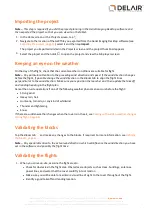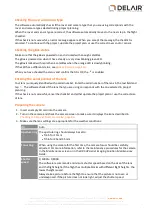
Importing the project
Note –
This step is required if you did the project planning in the Aerial Imaging Desktop software and
then exported the project so that you can view it on the tablet.
1. In the
Home
screen or the
Projects
screen, tap
.
2. Navigate to the location of the GWT file you exported from the Aerial Imaging Desktop software (see
Exporting the project, page 45
), select it and then tap
Import
.
The project you imported is listed in the
Projects
screen and the project thumbnail appears.
3. Select the project and then click
to open the project and view the
Map layers
screen.
Keeping an eye on the weather
On the day of the flight, check that the current weather conditions are suitable for flight.
Note –
Pay particular attention to the prevailing wind direction and speed. If the wind direction changes
before the flight, if possible change the wind direction in the Blocks tab to align the flight lines
perpendicular to the wind direction. Make sure you reposition the launcher and then update the takeoff
and landing heading in the flight plan.
Cancel the on-site operations if one of the following weather phenomena occurs before the flight:
l
Strong wind
l
Heavy rain, hail
l
Hurricane, tornado, or any kind of whirlwind
l
Thunder and lightening
l
Snow
If there are sudden weather changes when the rover is in the air, see
Dealing with sudden weather changes
.
Validating the blocks
Tap the
Blocks
tab
and make any changes to the blocks, if required. For more information, see
.
Note –
Pay special attention to the actual wind direction, which will influence the wind direction you have
set in the software and possibly the flight time.
Validating the flights
1. When you arrive on-site, examine the flight area to:
l
Check for obstacles in the flight area. Obstacles are objects such as trees, buildings, antennas,
power lines, and water that the rover could fly into or land on.
l
Make sure you will be able to maintain a visual line of sight to the rover throughout the flight.
l
Identify a good takeoff and landing location.
70
Delair-Tech
|
676, Rue Max Planck – 31670 Toulouse-Labège, France
|
Tel: +33 (0) 5 82 95 44 06
|
Capital: 238 110,30 € - APE: 3030Z – Intra-Community VAT number: FR90 53 09 69 781 – 530 969 781 R.C.S. Toulouse
This document is the sole property of Delair-Tech and cannot be used or reproduced without the written authorization of Delair-Tech
.






























